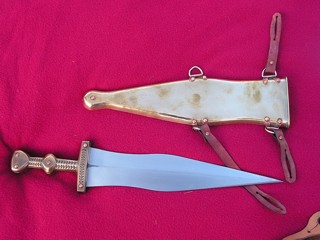About 50 AD a rod tang was introduced, and the hilt was no longer riveted through the shoulders of the blade. This in itself caused no great change in the pugio's appearance, but some ot these later blades were narower (under 1-3/4" wide), and/or had little or no waisting, and/or had reduced or vestigial midribs.
Throughout the period the outline of the hilt remained basically the same. It was made with 2 layers of horn or wood sandwiching the tang, each overlaid with a thin metal plate. The hilt plates were almost always iron, often thin sheet but sometimes solid. Occasionally the hilt was decorated with engraving or inlay. Note that the hilt is 3-1/2" to under 5" long overall and that the grip is quite narrow--it will always seem to be too small, and even the solid iron ones will not be very heavy.
Scabbards
In the 1st century BC pubio
scabbards were constructed much like sword scabbards: wood covered with
leather, in a metal frame with decorated metal panels. Early in
the 1st century AD, 2 new types of scabbard came into use, known for
convenience as type A and type B.
Type A had a metal shell consisting of a front and back plate with the edges worked over and soldered together. Inside was a wood or leather liner. Four suspension loops were held on by driving small nails through the shell and the liner, and clenching them over in back. Type B scabbards were leather-covered wood, with a metal plate fastened to the front by the same nails which secured the suspension loops.
A third, earlier type of scabbard was also in use in the 1st Century A.D., and featured a scabbard made of organic materials (probably wood-covered leather) and encased in a frame, surviving examples of which are iron.
Presumably there were leather
thongs or tabs on the suspension rings
which tied or "buttoned" to the frogs on the balteus.
The earlier frame-scabbard is appropriate for the early part of the 1st Century A.D., probably up to the time of the invasion of Britain in 43 AD. The type A scabbard disappeared after c. 50 AD, but the type B continued in use.
Most type A and B scabbards
were made with iron plates, and most of
those which have been published are inlaid, type A with enamel and
either brass or silver (or tin), type B with just silver or tin.
The scabbard of the Leeuwen dagger is brass, decorated with lines of
raised dots. There is also a brass sheath decorated with groups
of engraved parallel lines. It is possible that many dagger
scabbards were not decorated at all, but few plain scabbards have been
published.
Simple leather thongs are used to
tie the upper suspension rings to the frogs on the balteus. The
lower rings do not seem to have been used during the Empire.
Alternatively, a strip of thin leather c. 3/8" wide can be stitched to
each upper ring, and a slit cut in the free end to button over the stud
or disc on the frog. Or a longer strip with a slit at both ends
can be put through the ring and both ends buttoned over the same
frog.
Mark Morrow makes three types of excellent pugio blades: “Diamond Bladed” with no mid-rib, a plain mid-ribbed pugio, and a fullered (Type B) blade. Mark will hilt it for you, or he will supply you with the stamped hilt plates and you can hilt it yourself.
Matt Lukes is your best bet for a custom scabbard if you order a blade from Mark Morrow.
Len Morgan (Fabrica) also makes good custom pugios with scabbards.
Soul of the Warrior makes a good, inexpensive off-the-shelf pugio, the SOTW0028, with a nice early, 1st Century B.C type scabbard.
Deepeeka makes an “acceptable” off the shelf dagger, though it has problems: #3264B Brass Beaded Pugio. It is a reasonable copy of the Leeuwen dagger, though the scabbard is simply embossed (like most repros), whereas on the original the dots are cast in strips and soldered on. The scabbard may need an insert of wood or leather to keep the blade from rattling. The grip is a little too wide, and the way the hilt plates at the ends of the guard wrap around and overlap is badly done (and may not be correct anyway). The blade is often VERY blunt, and the midrib is too large. Overall, we rate this pugio as acceptable, though it can be improved with relatively simple modifications.
Deepeeka's #3264E Pugio Embossed is not on the
"acceptable" list, unfortunately. The method of decorating
the scabbard by riveting 4 incised brass plates to the front is not
found on any known original. There are other minor problems
(like the Brass Beaded version), but that is the fatal flaw.
Deepeeka's #3264R "Royal" pugio is
definitely unacceptable--colored enamel was not used in that way,
certainly not on a first century dagger. Their older pugio,
#3264, is also unusable, as is anything Museum Replicas/Windlass calls
a pugio.

